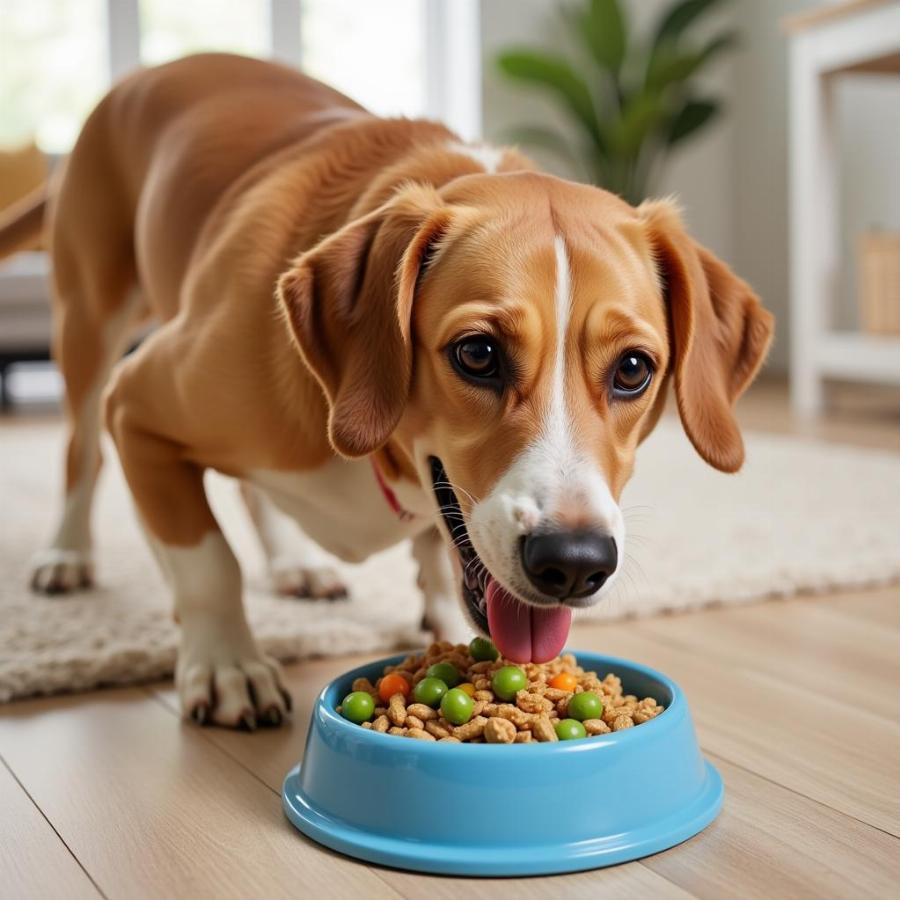Hemorrhoids in dogs, while less common than in humans, can cause discomfort and distress. Understanding the signs of hemorrhoids in dogs is crucial for early detection and appropriate treatment. This article will guide you through the common symptoms, causes, and potential solutions for this uncomfortable condition in your canine companion.
What Are Hemorrhoids in Dogs?
Technically, dogs don’t get hemorrhoids in the same way humans do. The term “hemorrhoids in dogs” is often used to describe a similar condition, more accurately termed perianal masses, which can include swollen blood vessels, abscesses, tumors, or inflamed anal glands. These masses can cause similar symptoms to human hemorrhoids, leading to confusion. Recognizing these symptoms is the first step in providing your dog with relief.
Recognizing the Symptoms of Perianal Issues in Dogs
Several signs may indicate your dog is experiencing perianal discomfort, possibly related to what is commonly referred to as “hemorrhoids”:
- Scooting or dragging their rear: This is often one of the most noticeable signs. Your dog may scoot their bottom along the ground or carpet in an attempt to relieve itching and irritation.
- Excessive licking or biting at the anal area: This can be a sign of inflammation and discomfort.
- Visible swelling or redness around the anus: Check your dog’s anal area for any noticeable abnormalities.
- Straining during bowel movements: If your dog seems to be struggling to defecate, it could be due to pain and swelling in the area.
- Blood in the stool or on the tissue after defecation: This can be a serious sign and requires immediate veterinary attention.
- Changes in bowel habits, such as constipation or diarrhea: Monitor your dog’s bowel movements for any changes in frequency or consistency.
Common Causes of Perianal Problems in Dogs
Several factors can contribute to perianal problems in dogs:
- Anal gland issues: Impacted or infected anal glands are a frequent cause of discomfort and can lead to swelling and inflammation.
- Constipation: Straining during bowel movements can exacerbate existing perianal issues or cause new ones.
- Diarrhea: Frequent, loose stools can irritate the sensitive skin around the anus.
- Allergies: Food or environmental allergies can cause inflammation and itching in the anal area.
- Tumors or growths: While less common, tumors or growths can develop in the perianal region.
What to Do if You Suspect Your Dog Has “Hemorrhoids”
If you notice any of the above symptoms, it’s crucial to consult a veterinarian. They can accurately diagnose the underlying cause of your dog’s discomfort and recommend appropriate treatment. Never attempt to treat your dog’s perianal issues yourself, as this could worsen the condition.
How Are Perianal Issues in Dogs Treated?
Treatment for perianal issues in dogs varies depending on the underlying cause. It may include:
- Anal gland expression: If impacted anal glands are the culprit, manual expression by a veterinarian can provide relief.
- Medications: Antibiotics may be prescribed for infections, while anti-inflammatory medications can reduce swelling and pain.
- Dietary changes: Adjusting your dog’s diet can help regulate bowel movements and alleviate constipation or diarrhea.
- Surgery: In rare cases, surgery may be necessary to remove tumors or address other complex issues.
Preventing Perianal Problems in Dogs
While not all perianal issues are preventable, some measures can help reduce the risk:
- Maintain a healthy weight for your dog: Obesity can contribute to anal gland problems.
- Feed a high-fiber diet: This can help regulate bowel movements and prevent constipation.
- Ensure your dog gets regular exercise: Exercise promotes healthy digestion and can help prevent constipation.
- Regular grooming: Keeping the anal area clean can reduce the risk of infection.
 Dog Eating Healthy Food
Dog Eating Healthy Food
Conclusion
While the term “hemorrhoids in dogs” is commonly used, it’s important to understand that the condition is usually related to other perianal issues. By recognizing the signs and seeking veterinary care promptly, you can ensure your furry friend receives the appropriate treatment and finds relief from discomfort. Early intervention is key to managing perianal problems and ensuring your dog’s overall well-being.
FAQ
- Can dogs get hemorrhoids like humans? Technically, no. The term is often used to describe similar perianal conditions.
- What is the most common cause of perianal problems in dogs? Impacted or infected anal glands are a frequent cause.
- Should I try to treat my dog’s “hemorrhoids” at home? No, always consult a veterinarian for diagnosis and treatment.
- How can I prevent perianal issues in my dog? Maintaining a healthy weight, a high-fiber diet, and regular exercise can help.
- Is surgery always necessary for perianal problems in dogs? No, surgery is typically only required for complex cases.
Related Articles You Might Find Helpful:
Beaut Dogs is your trusted source for all things canine. We are dedicated to providing dog owners with valuable information and expert advice on dog breeds, care, health, and training. For personalized support and answers to your specific questions, please contact us via Email at [email protected]. Beaut Dogs is here to help you navigate the wonderful world of dog ownership.